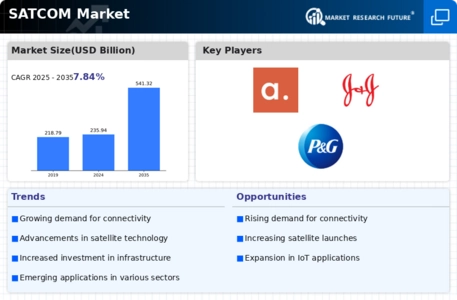Market Trends
Key Emerging Trends in the US SATCOM Market
The US SATCOM (Satellite Communication) market is experiencing several notable trends that are shaping its landscape. One prominent trend is the increasing demand for satellite connectivity across various industries and sectors. With the growing reliance on data-intensive applications, such as IoT (Internet of Things), telecommunication services, and remote sensing, there is a heightened need for robust and reliable satellite communication infrastructure. This demand is particularly pronounced in sectors like aviation, maritime, defense, and telecommunication, where seamless connectivity is essential for operations and services. As a result, satellite operators and service providers in the US are expanding their satellite fleets, investing in next-generation satellite technologies, and deploying innovative solutions to meet the growing demand for satellite communication services.
Another significant trend in the US SATCOM market is the emergence of new satellite constellations and mega-constellations aimed at providing global broadband coverage. Companies like SpaceX, OneWeb, and Amazon are leading the charge in deploying mega-constellations comprising hundreds or even thousands of small satellites in low Earth orbit (LEO). These constellations promise to deliver high-speed internet connectivity to underserved and remote regions worldwide, revolutionizing connectivity and bridging the digital divide. In the US, these developments are driving competition and innovation in the SATCOM market, as traditional satellite operators and new entrants vie for market share and seek to capitalize on the growing demand for broadband connectivity.
Additionally, there is a growing focus on enhancing satellite cybersecurity and resilience in the US SATCOM market. As satellite networks become increasingly interconnected and integrated into critical infrastructure systems, they are becoming more susceptible to cyber threats and attacks. In response, satellite operators, service providers, and government agencies are ramping up efforts to bolster satellite cybersecurity measures, implement robust encryption protocols, and enhance threat detection and mitigation capabilities. This trend reflects the recognition of the importance of securing satellite communications against potential cyber threats and ensuring the reliability and integrity of satellite networks.
Moreover, there is a notable shift towards the adoption of software-defined satellite technology in the US SATCOM market. Software-defined satellites offer greater flexibility, scalability, and efficiency compared to traditional hardware-based satellite architectures. By leveraging software-defined capabilities, satellite operators can dynamically reconfigure satellite payloads, allocate bandwidth more efficiently, and adapt to changing customer demands and market conditions in real-time. This trend is driving innovation in satellite design, manufacturing, and operations, as companies seek to capitalize on the benefits of software-defined satellite technology to stay competitive in the rapidly evolving SATCOM market.
Furthermore, there is a growing emphasis on sustainability and environmental responsibility in the US SATCOM market. Satellite operators and service providers are increasingly prioritizing the development and deployment of environmentally friendly satellite technologies and practices, such as electric propulsion systems, solar-powered satellites, and sustainable manufacturing processes. This trend reflects a broader recognition of the need to minimize the environmental impact of satellite operations and reduce carbon emissions associated with satellite launches and operations. By embracing sustainability initiatives, companies in the US SATCOM market can enhance their corporate image, attract environmentally conscious customers, and contribute to global efforts to address climate change and environmental degradation.






Leave a Comment